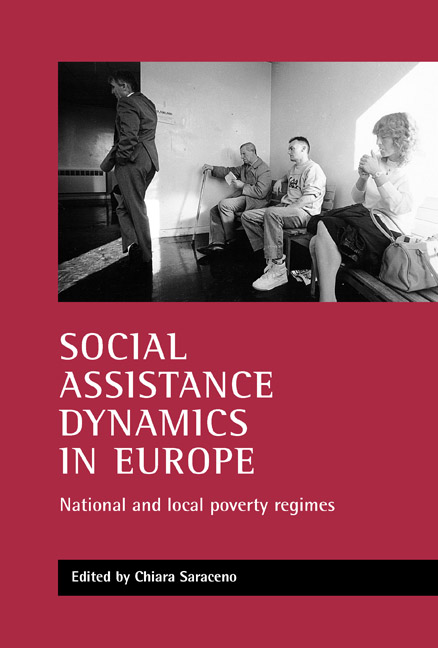Book contents
- Frontmatter
- Contents
- List of figures and tables
- Acknowledgements
- Notes on contributors
- one Introduction: exploring social assistance dynamics
- two Cities as local systems
- three Income support measures for the poor in European cities
- four Why some people are more likely to be on social assistance than others
- five Paths through (and out of) social assistance
- six Deconstructing the myth of welfare dependence
- References
- Appendix Institutional frameworks of income support policies in 13 European cities
- Index
one - Introduction: exploring social assistance dynamics
Published online by Cambridge University Press: 20 January 2022
- Frontmatter
- Contents
- List of figures and tables
- Acknowledgements
- Notes on contributors
- one Introduction: exploring social assistance dynamics
- two Cities as local systems
- three Income support measures for the poor in European cities
- four Why some people are more likely to be on social assistance than others
- five Paths through (and out of) social assistance
- six Deconstructing the myth of welfare dependence
- References
- Appendix Institutional frameworks of income support policies in 13 European cities
- Index
Summary
The social construction of the poor and of social assistance ‘careers’
In the German and Swedish cities of Bremen, Halle, Gothenburg and Helsingborg over 50% of social assistance recipients are young people under the age of 21. However, the same is true for only about one quarter of social assistance recipients in the French cities of Rennes and Saint Etienne, the Italian cities of Milan, Turin and Cosenza, the Spanish cities of Vitoria and Barcelona, and Lisbon and Porto in Portugal. In Barcelona and Lisbon, nearly half of social assistance recipients are aged over 40. At the same time, in the Swedish, German and French cities and also in Barcelona, the absolute or relative majority of recipients live in one person households, while in Lisbon, Vitoria, Milan, and to a lesser degree in Turin, the majority of recipients live in households that comprise three or more members. Childless households represent over two thirds of all households receiving social assistance in Bremen, Gothenburg, Helsingborg and Rennes, over half in Barcelona, Halle, Vitoria and Saint Etienne, but less than half in Lisbon, Milan and Turin. Whereas job loss is the main reason for entering social assistance in the German cities, and to a lesser degree in Barcelona, other causes (from marital disruption to sickness, disability, some kind of addiction, and the insufficiency of other sorts of welfare) are the main route into social assistance in Milan, Turin, Vitoria and Lisbon. As for the duration of social assistance recipiency, Helsingborg and Milan – the two cities with the fastest exit rate – show striking similarities, although the two programmes have contrasting features in terms of coverage, generosity and recipients’ obligations.
These cross-country and within-country differences, as well as unexpected similarities, are the empirical findings of our study and are the object of our investigation. What is their cause? How can they be explained on the basis of what we know concerning the incidence of poverty, the unemployment rates by age and gender, and the generosity and variety of social assistance systems in the various countries and cities? We cannot easily argue that the young and childless in Germany and Sweden are more vulnerable to unemployment and poverty than in Portugal, Italy and Spain, and more in Bremen than in Halle.
- Type
- Chapter
- Information
- Social Assistance Dynamics in EuropeNational and Local Poverty Regimes, pp. 1 - 34Publisher: Bristol University PressPrint publication year: 2002



